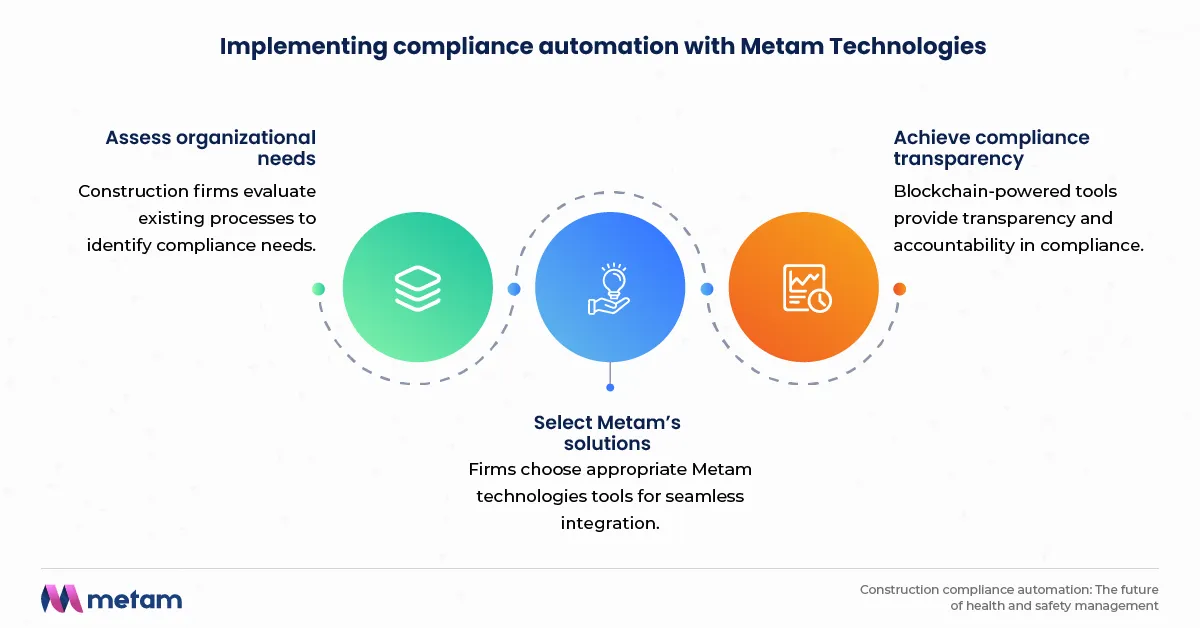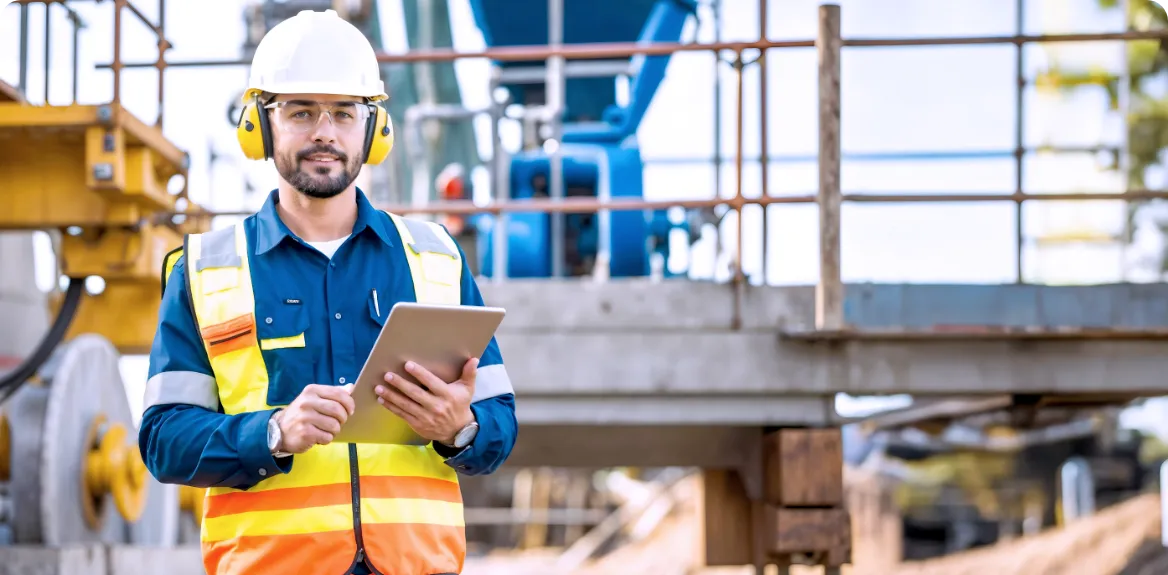Construction compliance automation: The future of health and safety management
by
Metam technologies

Abstract
This article explores the transformative role of compliance automation in construction health and safety management, highlighting its benefits, challenges, and the solutions provided by Metam Technologies.
Table of Content
What is construction compliance automation and why does it matter?

How is automation transforming health and safety management in construction?

What challenges might arise with compliance automation and how can they be overcome?

 What are the key benefits of automating compliance processes?
What are the key benefits of automating compliance processes?

How can construction firms implement compliance automation successfully with Metam Technologies?

Key takeaways

The construction industry is evolving rapidly, and ensuring health and safety compliance is more challenging than ever. Navigating complex regulatory landscapes, mitigating on-site hazards effectively, and streamlining compliance processes without compromising efficiency are top priorities for construction firms today.
The imperative for change is clear. According to recent industry reports, approximately 69% of construction firms have witnessed enhanced safety and compliance outcomes after integrating software solutions. This surge underscores the growing reliance on AI and automation to address the sector’s evolving needs.
This article explores how automation is revolutionizing construction compliance, enhancing health and safety management, and shaping the industry's future.
What is construction compliance automation and why does it matter?
Construction compliance automation integrates technology to ensure adherence to health and safety regulations more efficiently. It replaces manual processes, ensuring greater accuracy and consistency. In a landscape marked by ever-evolving regulations and increased safety demands, compliance automation is no longer optional, it’s essential.
Defining construction compliance automation
Compliance automation refers to the use of digital tools and software to track and enforce construction regulations. This includes using platforms to monitor safety protocols, document compliance efforts, and generate reports, all without manual intervention. Automation reduces errors, saves time, and ensures better accuracy in adhering to health and safety standards.
Importance of compliance automation in modern construction
As the construction industry faces increasingly complex health and safety regulations, automation has become indispensable for managing compliance efficiently. It helps mitigate the risk of errors, simplifies compliance workflows, and ensures consistent safety across large-scale projects.
By automating these processes, construction firms can reduce the administrative burden, enhance reporting accuracy, and maintain a higher standard of safety. This makes compliance automation a critical asset in maintaining operational efficiency and reducing compliance-related risks in today’s fast-paced construction environment.
Compliance automation has therefore become crucial for several reasons:
- Minimizing human error: Automation reduces the risk of errors associated with manual data entry, paperwork, and communication, leading to more accurate and reliable compliance records.
- Streamlining workflows: By automating repetitive tasks and processes, companies can free up their staff to focus on more strategic and value-added activities.
- Ensuring scalability: Automation enables companies to effectively manage compliance across multiple projects and locations, regardless of size or complexity.
- Improving transparency and accountability: Digital records and audit trails provide greater transparency into compliance activities, making it easier to demonstrate compliance to regulatory agencies and stakeholders.
- Reducing costs: By preventing compliance violations, avoiding penalties, and improving efficiency, automation can help companies significantly reduce their compliance-related costs.
- Enhancing safety: Real-time monitoring and proactive risk identification can help prevent accidents and injuries, creating a safer work environment for construction workers, which is a top priority.
How is automation transforming health and safety management in construction?
Automation is reshaping how health and safety management is conducted on construction sites. By implementing cutting-edge technologies, such as robotics and real-time data analytics, construction firms can proactively manage risks and ensure a safer working environment.
These advancements not only improve operational efficiency but also drastically enhance worker safety.
- Implementation of robotics and ai : The integration of robotics and artificial intelligence in construction tasks, such as material transport and welding, significantly enhances safety by reducing human exposure to high-risk situations. Robots handle dangerous tasks with precision, preventing accidents caused by human error while boosting overall productivity.
- Real-time data analytics : AI-powered predictive analytics are transforming how construction companies foresee potential safety issues. By analyzing historical data and real-time site information, AI systems can identify trends and predict possible hazards, allowing firms to take preemptive action before incidents occur.
- Automated risk assessment tools : Automation streamlines risk assessments by continuously monitoring site conditions and flagging potential safety hazards in real-time. These tools provide an in-depth analysis of site risks, enabling teams to mitigate problems before they escalate into major safety concerns.
- Drones for site monitoring : Drones are revolutionizing site inspections by providing real-time data on safety conditions. With their ability to capture detailed images and footage, drones allow managers to identify hazards from angles that would be difficult or dangerous for humans to assess.
- Wearable technology for safety : Wearable technology such as smart helmets and vests are monitoring worker health and safety in real-time. These devices collect data on workers' vital signs, posture, and even environmental factors, helping to prevent accidents and respond promptly to any signs of distress.
- Blockchain for compliance tracking : Blockchain is being used to enhance compliance tracking by providing a secure, transparent ledger of all safety-related activities and documentation. This ensures that compliance data is tamper-proof and easily accessible, boosting accountability and transparency in construction projects.
What challenges might arise with compliance automation and how can they be overcome?
Despite the many advantages of automation, there are several challenges construction companies may face when adopting compliance automation technologies. Addressing these hurdles head-on is crucial for successful implementation and long-term success in health and safety management.
- Initial implementation costs : The initial costs of implementing compliance automation solutions can be high, particularly for small to mid-sized construction companies. However, the long-term savings and efficiency gains can outweigh these upfront expenses. Strategic budgeting and exploring financing options can make the transition more feasible.
- Resistance to change : Many construction professionals are accustomed to traditional compliance processes. Overcoming resistance to change requires demonstrating the tangible benefits of automation through case studies and providing training programs to ensure smooth adoption.
- Data security concerns : With the increase in digital tools comes the need for robust cybersecurity measures. Protecting sensitive compliance data from breaches is critical, and adopting industry-leading security protocols ensures the integrity and safety of all digital compliance records.
- Complexity of integrating new systems : Integrating new compliance automation systems with existing infrastructure can be complex. Companies should invest in consultation and support services from automation providers, ensuring seamless integration and reducing disruptions during the transition period.
- Balancing automation with human oversight : While automation improves efficiency, it should not replace human oversight entirely. A balanced approach, where automation handles routine tasks and human expertise oversees complex decision-making, ensures the continued effectiveness of health and safety management systems.
 What are the key benefits of automating compliance processes?
What are the key benefits of automating compliance processes?
Automating compliance processes not only simplifies operations but also offers significant benefits, from enhancing efficiency to improving safety outcomes. Construction companies that adopt automation can expect improved operational performance and a more secure working environment for their employees.
- Enhanced efficiency : Automation streamlines the compliance process by eliminating manual paperwork and reducing administrative tasks. By automating routine checks and reports, construction firms can focus their resources on more strategic initiatives while maintaining regulatory compliance.
- Improved accuracy : Human error is a common cause of compliance failures in construction. Automated systems ensure accurate tracking of compliance-related activities and reporting, reducing the risk of mistakes and ensuring that safety protocols are followed to the letter.
- Cost reduction : By reducing the likelihood of non-compliance penalties, accidents, and safety violations, automation helps construction firms lower their operational costs. These cost savings can be reinvested in other areas of the business to support growth and innovation.
- Real-time monitoring and reporting : Automated systems enable continuous monitoring of health and safety compliance, offering up-to-the-minute insights into any safety concerns or violations. This real-time tracking improves responsiveness and allows construction companies to act quickly when issues arise.
- Scalability of compliance operations : As construction projects grow in size and complexity, automated compliance processes allow companies to scale their operations without sacrificing the quality or effectiveness of safety management practices. Automated tools can easily handle the demands of larger projects, ensuring compliance across multiple sites.
How can construction firms implement compliance automation successfully with Metam Technologies?
Metam Technologies provides a suite of solutions and services designed to help construction firms implement compliance automation seamlessly. With the right strategy and support from Metam’s solutions, construction companies can overcome implementation challenges and achieve higher efficiency in health and safety management.

- Assessing organizational needs with Metam : Before implementing compliance automation, it’s essential for construction firms to assess their current processes and identify areas for improvement. Metam offers comprehensive analysis tools to help businesses understand their compliance needs and determine where automation can bring the most value.
- Selecting Metam's solutions for seamless integration: Choosing the right automation solutions is key to ensuring smooth integration into existing workflows. Metam offers scalable solutions that integrate easily with existing systems, minimizing disruptions and maximizing the benefits of automation across the entire organization.
- Achieving full compliance transparency: Metam’ blockchain-powered compliance tools provide complete transparency and accountability, ensuring that every step of the compliance process is documented securely. This transparency helps mitigate risks and offers stakeholders confidence in the firm’s commitment to safety and regulatory adherence.
Key takeaways
Construction compliance automation is no longer a luxury but a necessity in today’s industry. It drives substantial improvements in safety standards, operational efficiency, and cost management, all while ensuring rigorous adherence to regulatory requirements. By integrating automated systems early, construction companies position themselves for long-term success, reducing risks, minimizing human error, and fostering a culture of proactive compliance.
With the expertise and advanced solutions offered by Metam Technologies, businesses can seamlessly navigate the complexities of modern construction compliance, gaining a competitive advantage and paving the way for safer, more efficient project execution. Embracing these transformative technologies will not only future-proof operations but also ensure that construction firms remain leaders in the evolving landscape of health and safety management.

Construction compliance...
This article explores the transformative role of compliance automation in construction health and safety management,...




